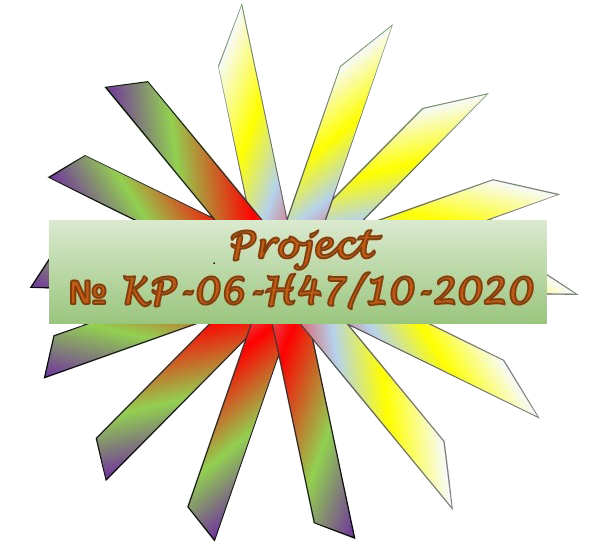Project objectives and hypotheses
The aim of this project is a detailed and systematic study of the conditions for the synthesis of ceramic pigments in the system ABM2O6, where M = Si, Al; A = Ca, Na; B = Mg, V, Cr, Mn, Fe, Co, Ni, Al, TR (La, Pr, Nd, Er) – diopside and augite pyroxene matrix, the effect of chromophore transition metal impurities on the parameters of synthesis, phase composition, colour, structural and physicochemical features and properties. The properties to be measured are colour characteristics as defined by the International Commission on Illumination (CIE), optical transmission and wide-range absorption (0.2 to 5 µm), reflectance and more.
The main hypothesis of the project is that, by doping with appropriate impurities, it is possible to change the optical parameters of the material in a controlled manner so as to obtain new pigment colours as well as to change some physical properties.
Defects are usually formed in the process of crystal growth (non-stoichiometric / intrinsic defects); oxidation / reduction (thermochemical defects); when doping appropriate impurities (extrinsic). Important characteristics of chromophore impurities are their concentration and spatial distribution, their valence state and their ability to change valence state depending on the symmetry of its position in the crystal lattice. The basic principle for modifying properties by incorporating impurities is that this disrupts the ideal crystalline structure and the atomic interactions therein, thereby altering electronic and vibrational energy states.
Another working hypothesis that will be tested within the project is that waste products can be used and utilized in the synthesis of diopside ceramic pigments. Based on our experience so far and the literature, we will focus our efforts on the use of two types of waste – petroleum catalysts and spent vanadium catalysts from sulfuric acid production.
Approaches for accomplishment of the research goals including interdisciplinarity of the project
One of the goals of the project is to apply a combined scientific approach and strategy to study the effect of different impurity elements (concentration, valence state, ionic radius, crystallographic position, electronic states) on the structure and optical properties of ceramics. The relevant X-ray diffraction data, precession electron diffraction data, vibrational spectra (Raman and infrared), UV-VIS-NIR optical absorption spectra, EPR, photoluminescent spectra, colour coordinates will be analyzed simultaneously. Such an approach makes it possible to different levels of the interaction energy in the medium: (1) phonon interactions sensitive to the structure of the material (atomic coordination, force constants, topology, etc.); (2) electronic transitions sensitive to the crystal field, defects, impurity atoms, etc. and (3) electronic transitions sensitive to the valence state of the ions that modify the structure.
The tasks and their implementation by individual teams and laboratories are described in detail in the Research plan.
The team has a preliminary cooperation agreement between the University of Ruse “Angel Kanchev” and the Institute of Mineralogy and Crystallography “Acad. Ivan Kostov”, as well as foreign participants from the Institute of Inorganic Chemistry, Czech Academy of Sciences and the State University of Chemical Technology, Dnepropetrovsk, Ukraine.
The synthesis of various types of ceramic pigments and the study of their structure and properties are complex. In addition to the specialists in the Department of Chemistry and Chemical Technologies, University of Ruse who are familiar with the technologies related to the synthesis of new materials, the participation of researchers from the Departments of Materials Technology and Materials Science, the Department of Ecology and Environmental Protection and others is crucial. Specialists from the Department of Computer and Information Technologies and the Central Research Laboratory of Ruse University will be involved in modelling process.
The team at IMC-BAS will perform the complete characterization of the obtained ceramics by determining the phase composition by X-ray powder diffraction (XRD) applying Rietveld method refinements; morphological characteristics by scanning electron microscopy; chemical composition by SEM- EDS and WDS spectroscopy and LA-ICP-MS, X-ray fluorescence analysis, and atomic resolution HRTEM microscopy; influence of impurity ions on the structural characteristics and vibrational states by infrared and Raman spectroscopy; optical characteristics in the UV-VIS-NIR range, thermal properties, etc. External laboratories will be used for some of the necessary analyzes (EPR spectroscopy, X-ray emission spectroscopy, AFM, photoelectric properties, etc.).
